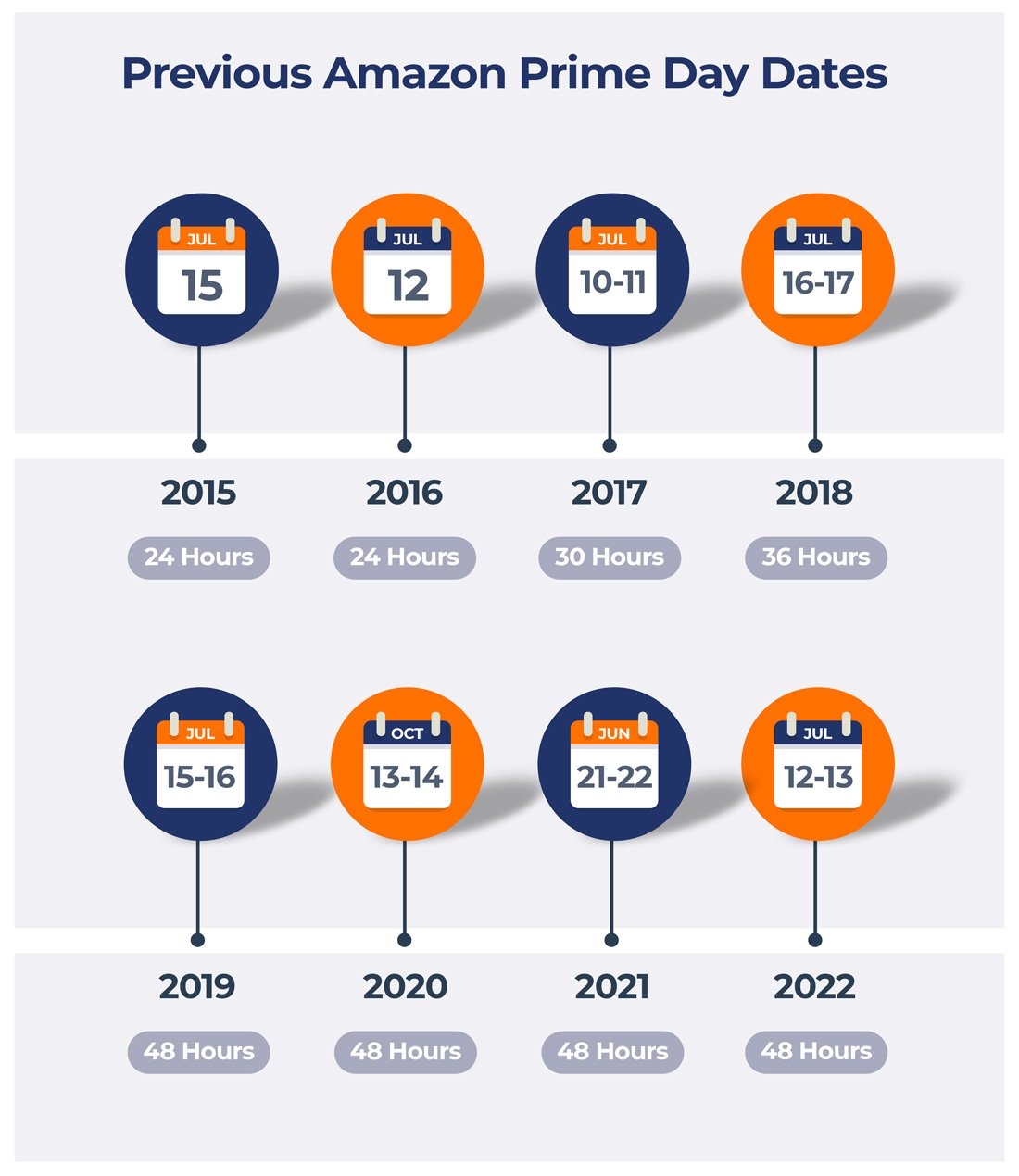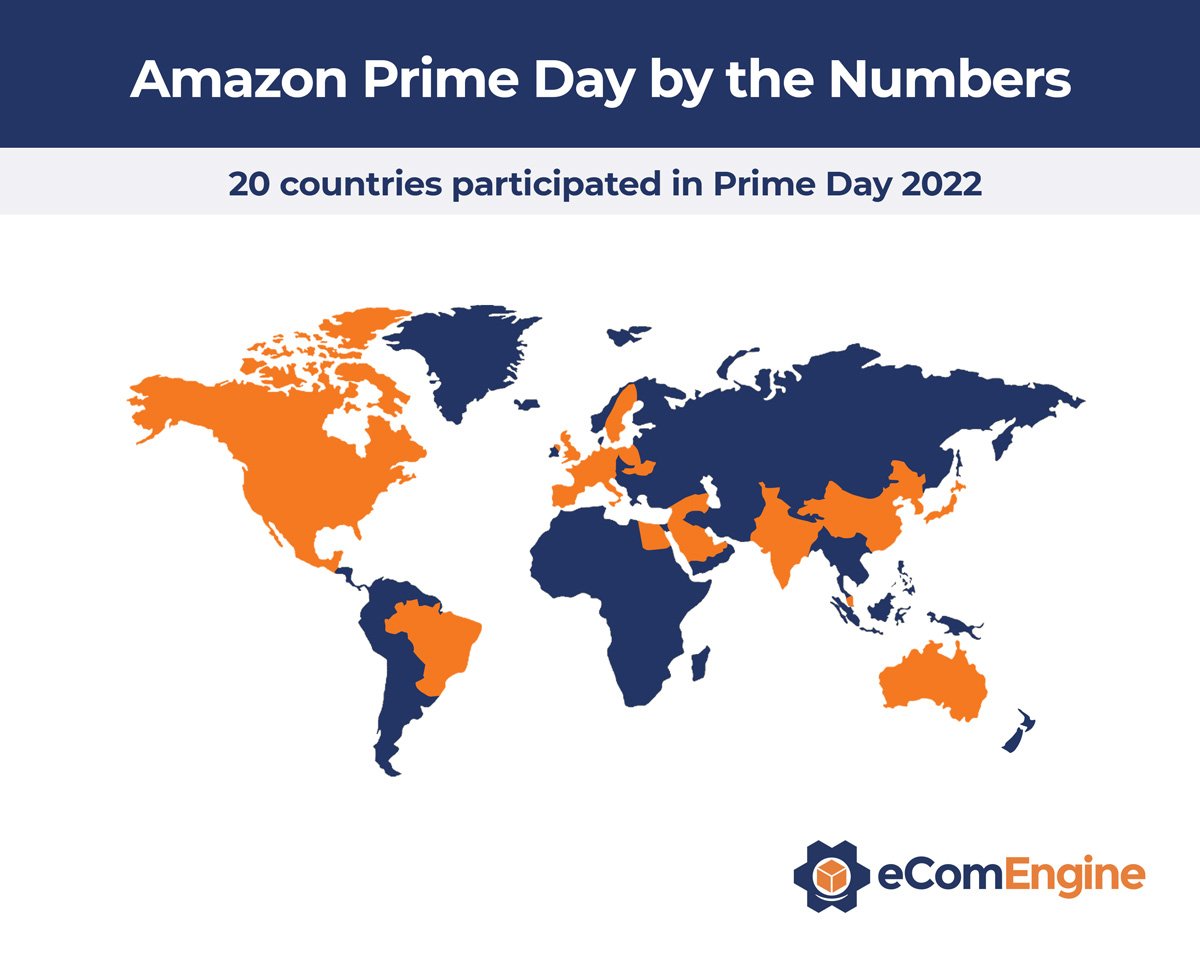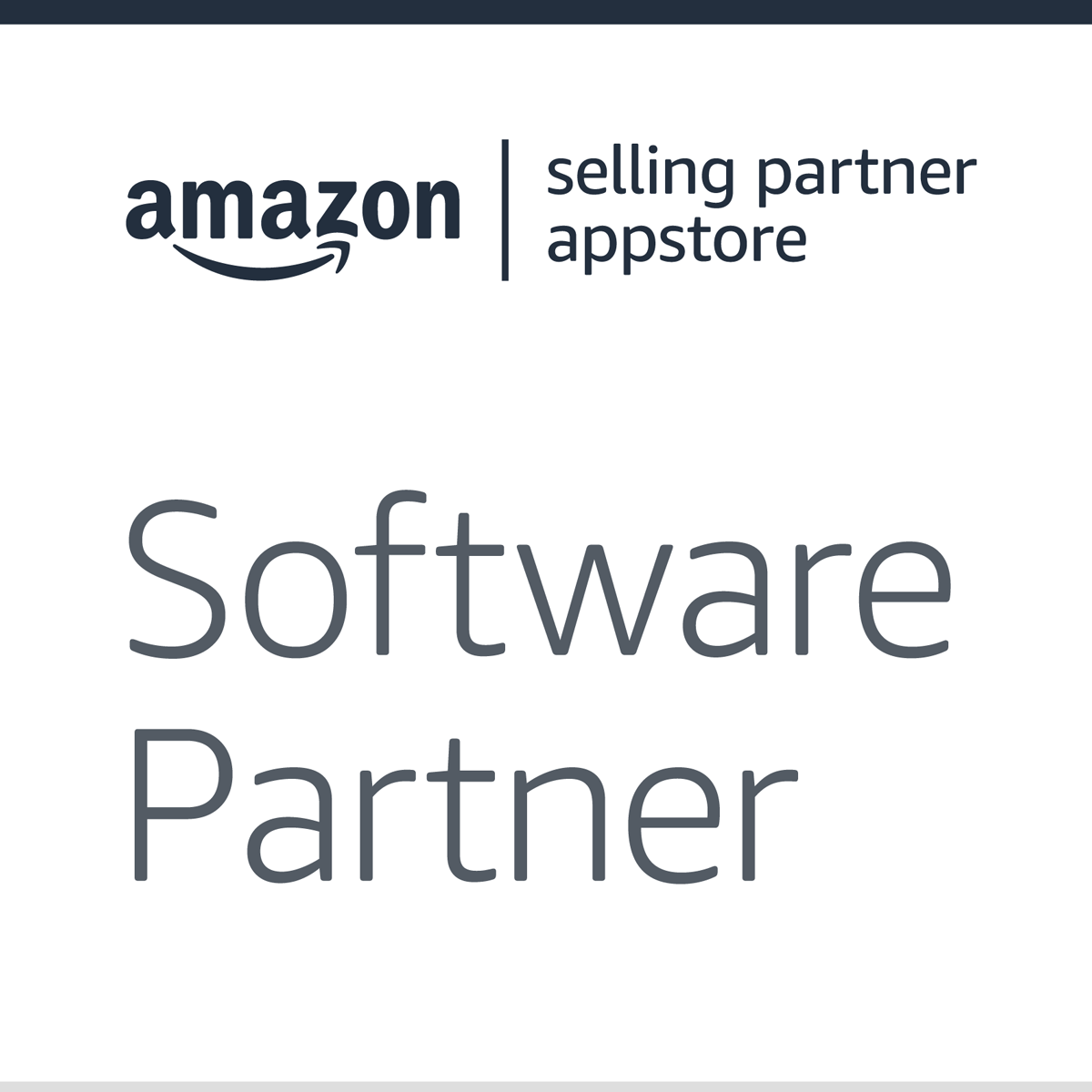Originally published on May 29, 2019, updated June 17, 2025
Menu
Join Our Email List
- Receive our monthly newsletter.
- Stay up to date on Amazon policies.
- Get tips to grow your business.
The annual Amazon Prime Day event often leads to increased sales, even if you’re not offering deals or running promotions. With additional traffic (and competition), having the right Prime Day strategy can help boost your profits.
July 8- 11, 2025 marks the tenth anniversary of this annual event, which is sure to be the biggest yet. We’ll share dates and more details when available, but for now you should know that Prime Day 2025 will be the biggest event yet!
 Like Cyber Monday and other major online shopping events, many Amazon sellers report an increase in sales in the days surrounding Prime Day. As a seller, you should be prepared for even higher demand during the event.
Like Cyber Monday and other major online shopping events, many Amazon sellers report an increase in sales in the days surrounding Prime Day. As a seller, you should be prepared for even higher demand during the event.
With proper planning, your Amazon Prime Day revenue can soar. However, remember that even a minor snafu can have huge consequences. Key areas to refine before the event begins are detailed below.
Shoppers rely on your Amazon listing since they can't physically evaluate your products. Every detail counts! Your connection with each shopper begins on the product detail page. Set the right tone by ensuring your listings provide the details shoppers need, from sizing information to product images. Misleading or incorrect product details can lead to negative reviews and a poor customer experience.
Include relevant keywords and details to help shoppers find your product through your ads and organic search. Update A+ Content and add product videos. According to Amazon, listings with videos get an 9.7% higher conversion rate on average compared to listings without videos.
Related reading: Amazon Listing Guide and Best Practices
View your listings on mobile to see if you need to make any changes for a better shopping experience. Take time to review your listings from the buyer’s perspective and make any changes needed to ensure product details, features, and benefits are easy to understand
In the weeks leading up to Amazon Prime Day, ensure you have enough inventory in stock to meet increased demand. Amazon recently added the Minimum Inventory Level metric for FBA sellers, which can lead to a low-inventory-level fee if supply is not maintained over time. FBA sellers are encouraged to keep between one and six months of inventory in stock at Amazon's fulfillment centers.
Shipments must arrive by the following dates to be eligible for the Prime badge.
Need help knowing what to restock and when? RestockPro by eComEngine is an FBA inventory management platform that helps you forecast inventory needs, monitor profits, identify aging inventory, and stay in stock. RestockPro also offers a free integration with Aura's AI-powered repricer!
You may need to purchase additional FBA capacity or be prepared to fulfill orders from your warehouse or a 3PL if you're running Prime Day promotions or anticipating increased sales for a trending product. If you fulfill orders through Seller Fulfilled Prime, be sure to build in plenty of bandwidth for you and your team to get orders out on time.
Prime Day can also be a great time to test new products and sell items you no longer wish to stock quickly before Q4. Check out these Prime Day inventory management tips to learn more!

We anticipate that Prime Day and the days surrounding it will continue to be a very successful time for Amazon sellers worldwide. Being prepared by having enough inventory in stock and a strategic plan for promoting products can help sellers maximize profits during this high-volume sales window.Jay Lagarde
When it comes to Prime Day advertising, this is the time to boost your budget. Amazon recommends setting campaigns before Prime Day and allowing them to run for at least two weeks. This is a good time to be competitive and strategic with your bids.
Brands will need to make sure they are getting as much visibility as possible and converting that traffic at a high rate to have the best performance during Prime Day and Prime Day week.
From a product discoverability standpoint, Amazon's suite of advertising products are the most powerful tools in a brand's arsenal during the Prime Day period."
-Pat Petriello, Head of Marketplace Strategy, Tinuiti
You can also create coupons or offer special promotions such as a percentage off to generate interest in your products. For example, during the event items with a Prime Exclusive Deal will enjoy visibility on deals pages and display a Prime Day Best Deals badge.
Prime-Exclusive Best Deals run for the entire event and may perform well with best sellers in your catalog. The Prime Day fee is $100 per Best Deal. These can be submitted under Advertising > Deals > Create a new deal > Show eligible products for Prime-Exclusive Best Deals in Seller Central.
You must be a professional seller with an overall rating of 4.0 stars or above to be eligible to run Amazon Deals. You also need to receive a minimum of five seller feedback ratings each month and have a minimum of a 3.5-star rating.
Products must have:
Amazon specifies the minimum percentage of product variations that must be included when you create your deal. Restricted products and those that are deemed offensive, embarrassing, or inappropriate aren't eligible for deals. Products with high return rates are ineligible for deals.
Prime-Exclusive Lightning Deals allow you to offer a steep discount for a short time, up to 12 hours or until sold out. Costs can be high since you’re offering a major discount in addition to Amazon’s $500 per deal fee, but these deals are often effective for clearing out inventory and boosting brand visibility.
Prime-Exclusive Price Discounts can be submitted starting in May. These discounts are only available for Prime members and you’re charged a flat $100 fee per Prime-Exclusive Price Discount campaign supporting up to 500 SKUs.
Prime Member Coupons can be created after the event dates are announced. These are point-of-sale promotions that are offered exclusively to Prime members for a single product or set of products. You can run coupons on a single ASIN or set of ASINs, offering a dollar amount or percentage off. The Prime Day fee is $5 per coupon plus 2.5% of coupon sales.
Seller feedback and product reviews are important parts of your overall Amazon seller reputation. Great ratings can help you stand out from the crowd during a busy sales period, but negative ratings can cause significant damage to your sales.
Proactive reputation management is key to year-round success on Amazon, but having strong ratings is even more crucial during a competitive time such as the weeks surrounding Prime Day and Cyber Monday.
Seller feedback ratings affect your Buy Box eligibility. Increasing your average feedback rating can help you win the Buy Box more often.
Your Amazon reviews could mean the difference between a great conversion rate and poor sales during what should be a very successful selling period. Regularly requesting reviews and managing your seller reputation can help you keep your Amazon business healthy during Prime Day and beyond.
You’ll likely see an increase in order volume around Prime Day, so it’s a great time to request Amazon reviews and feedback. In 2020, we saw a 32% increase in reviews received by a random sample of FeedbackFive customers in the week after Prime Day.
Need more feedback and reviews? You can use FeedbackFive to send automated Amazon-compliant requests, get alerts for negative feedback, and more. (Click here to start your free trial!)
Watch the video below to get our Prime Day tips for Amazon reviews.
Amazon is an incredibly competitive marketplace. High-traffic events like Prime Day can make your listings a target for hijacking. Other issues such as search suppression or a suppressed Buy Box could mean that shoppers don't even see your products in search.
SellerPulse by eComEngine automatically alerts you when there's an issue such as a listing change, search suppression, or Buy Box change. Try it free to protect your listings this Prime Day!
Although seasonality and product trends play a big role in what sells well during the Prime Day event, most sellers see an uptick in sales. Many buyers know the event is on the horizon and may be planning to purchase items during the event regardless of discount status.
So while Prime Day is not a perfect testing ground for the remainder of the year, sales trends from the event can offer insight into future inventory planning. The additional traffic can help you identify what’s going well and what to try to improve.
Sifting through all that data to get insights is time-consuming. Tools like SellerPulse provide the details you need at a glance. Check out the KPI Benchmark Summary Report to quickly assess overall business health.

Amazon Prime Day began in 2015 to celebrate Amazon’s 20th birthday. It has significantly grown each year. In 2018, despite some technical glitches, it was Amazon’s biggest sales day ever — at least for a little while.
Prime Day 2019 soon stole the crown as the largest shopping event in Amazon history with sales surpassing the previous Black Friday and Cyber Monday combined.
When the COVID-19 outbreak brought everything to a halt, the 2020 event was delayed several times due to the pandemic before finally happening on October 13-14, 2020.
Prime Day 2021 took place in June. Customers didn't seem to mind its earlier-than-expected arrival—it was the most successful two-day period ever for Amazon’s third-party sellers, most of which are small and medium-sized businesses. In the promotional period leading up to the event, customers spent over $1.9 billion on more than 70 million small business products.
Despite rising inflation and ongoing supply chain issues, Amazon managed yet another record in 2022 with more than 300 million products being purchased worldwide. 2023 Prime Day sales surpassed $12.9 billion globally. The 2024 event was the biggest ever, with over 200 million items sold by independent sellers.

Over the years, other retailers have jumped on the bandwagon to offer similar deals around Prime Day to capitalize on a sales boost during a normally sluggish time of year. If you’re a shopper looking to make a big purchase, it might be worth it to wait until around Prime Day!
With all this talk of just how big Prime Day has become, we would be remiss not to share more of its incredible reach and a few more interesting tidbits!
The Amazon Prime program has grown to include more than 200 million members worldwide. These are the countries participating in Prime Day 2025: Australia, Austria, Belgium, Brazil, Canada, Egypt, France, Germany, India, Ireland, Italy, Japan, Luxembourg, Mexico, the Netherlands, Poland, Portugal, Saudi Arabia, Singapore, Spain, Sweden, Turkey, the United Arab Emirates, the US, and the UK.

Discover more interesting info about past Prime Day events!
Do you have questions about Prime Day? Want to share your success or struggles from last year? Let us know in the comments and be sure to check out the resources listed below!
Originally published on May 29, 2019, updated June 17, 2025
This post is accurate as of the date of publication. Some features and information may have changed due to product updates or Amazon policy changes.
These Stories on Amazon
14321 Winter Breeze Drive
Suite 121 Midlothian, VA 23113
Call us: 800-757-6840





Copyright© 2007-2025 eComEngine, LLC. All Rights Reserved. eComEngine®, FeedbackFive®, RestockPro®, and SellerPulse® are trademarks or registered trademarks of eComEngine, LLC. Amazon's trademark is used under license from Amazon.com, Inc. or its affiliates.
Comments (1)